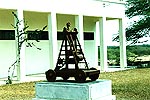 Banbhore is also associated with the
famous romance of Sassi and Punnu described by a local folklore. Sassi
belonged to Banbhore. The museum at the site houses a rich collection of
painted pottery, coins and beads etc. About the 10th century it was the
capital of a chief Bhambo Raja and was named Bhambor after him. This
town was later destroyed in 1250 A.D. In the center of a semi-circular
palatial building remains of a mosque with numerous Kufic inscriptions
carved on dressed stone slabs reveal that this was the earliest yet
known mosque of the sub-continent. Its discoveries throw light not only
on the Muslim era but also on pre-muslim times. They tell us about the
civilization of early centuries of the Christian era. Some human
skeletons have also been found in streets and houses. The Hindu temple
of the pre-Muslim era has also been unearthed along with coins belonging
to Khilafat period. Other stone, glass and ivory objects, pottery,
jewelry, arms and certain human skeletons with arrows in their heads
show that this town came to a violent end.
Banbhore is also associated with the
famous romance of Sassi and Punnu described by a local folklore. Sassi
belonged to Banbhore. The museum at the site houses a rich collection of
painted pottery, coins and beads etc. About the 10th century it was the
capital of a chief Bhambo Raja and was named Bhambor after him. This
town was later destroyed in 1250 A.D. In the center of a semi-circular
palatial building remains of a mosque with numerous Kufic inscriptions
carved on dressed stone slabs reveal that this was the earliest yet
known mosque of the sub-continent. Its discoveries throw light not only
on the Muslim era but also on pre-muslim times. They tell us about the
civilization of early centuries of the Christian era. Some human
skeletons have also been found in streets and houses. The Hindu temple
of the pre-Muslim era has also been unearthed along with coins belonging
to Khilafat period. Other stone, glass and ivory objects, pottery,
jewelry, arms and certain human skeletons with arrows in their heads
show that this town came to a violent end.
This is the site of a large town that existed at least 1400 years ago. The pieces of pottery found by archaeologists are similar to those found at Taxila and known to be of the 1st century B.C. Banbhore has given our museums a strong archeological heritage. One which attracts tourists from all corners and all continents.


